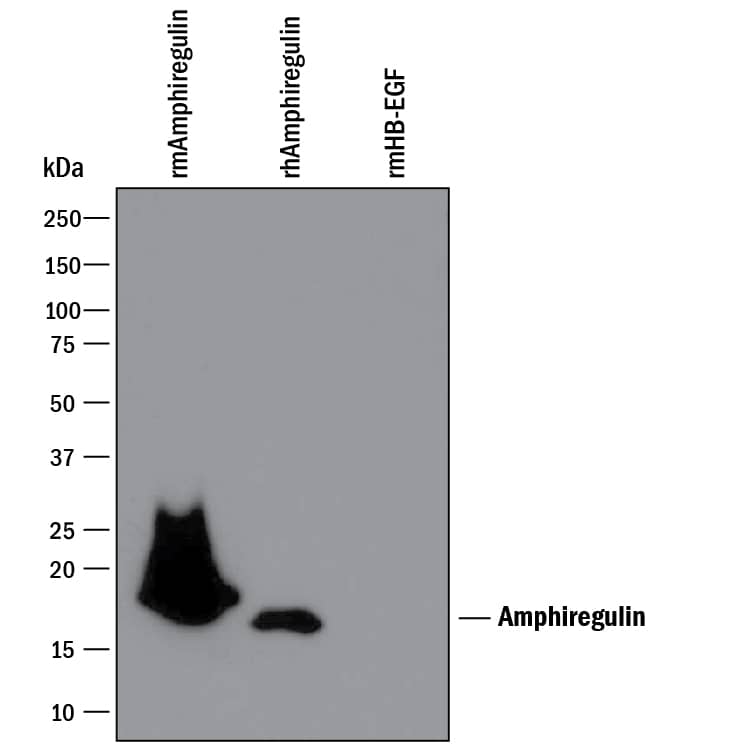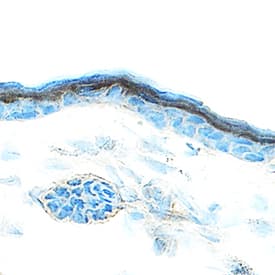Mouse Amphiregulin Antibody
R&D Systems, part of Bio-Techne | Catalog # AF989


Key Product Details
Species Reactivity
Validated:
Cited:
Applications
Validated:
Cited:
Label
Antibody Source
Product Specifications
Immunogen
Ser94-Lys191
Accession # P31955
Specificity
Clonality
Host
Isotype
Endotoxin Level
Scientific Data Images for Mouse Amphiregulin Antibody
Detection of Recombinant Human and Mouse Amphiregulin by Western Blot.
Western blot shows 25 ng of Recombinant Mouse Amphiregulin (Catalog # 989-AR), Recombinant Human Amphiregulin (Catalog # 262-AR), and Recombinant Mouse HB-EGF. PVDF Membrane was probed with 0.1 µg/mL of Goat Anti-Mouse Amphiregulin Antigen Affinity-purified Polyclonal Antibody (Catalog # AF989) followed by HRP-conjugated Anti-Goat IgG Secondary Antibody (Catalog # HAF109). A specific band was detected for Amphiregulin at approximately 16-25 kDa (as indicated). This experiment was conducted under reducing conditions and using Immunoblot Buffer Group 3.Amphiregulin in Mouse Skin.
Amphiregulin was detected in immersion fixed frozen sections of mouse skin using Goat Anti-Mouse Amphiregulin Antigen Affinity-purified Polyclonal Antibody (Catalog # AF989) at 15 µg/mL overnight at 4 °C. Tissue was stained using the Anti-Goat HRP-DAB Cell & Tissue Staining Kit (brown; Catalog # CTS008) and counterstained with hematoxylin (blue). Specific staining was localized to keratinocytes. View our protocol for Chromogenic IHC Staining of Frozen Tissue Sections.Cell Proliferation Induced by Amphiregulin and Neutralization by Mouse Amphiregulin Antibody.
Recombinant Mouse Amphiregulin (Catalog # 989-AR) stimulates proliferation in the Balb/3T3 mouse embryonic fibroblast cell line in a dose-dependent manner (orange line). Proliferation elicited by Recombinant Mouse Amphiregulin (50 ng/mL) is neutralized (green line) by increasing concentrations of Mouse Amphiregulin Antigen Affinity-purified Polyclonal Antibody (Catalog # AF989). The ND50 is typically 0.3-1.5 µg/mL.Applications for Mouse Amphiregulin Antibody
Immunohistochemistry
Sample: Immersion fixed frozen sections of mouse skin
Western Blot
Sample: Recombinant Mouse Amphiregulin (Catalog # 989-AR)
Neutralization
Mouse Amphiregulin Sandwich Immunoassay
Formulation, Preparation, and Storage
Purification
Reconstitution
Formulation
Shipping
Stability & Storage
- 12 months from date of receipt, -20 to -70 °C as supplied.
- 1 month, 2 to 8 °C under sterile conditions after reconstitution.
- 6 months, -20 to -70 °C under sterile conditions after reconstitution.
Background: Amphiregulin
Amphiregulin (AR), also known as Schwannoma-derived growth factor (SDGF), is a member of the epidermal growth factor (EGF) family of growth factors which includes, AR, EGF, transforming growth factor-a (TGF-a), heparin binding EGF-like growth factor (HB-EGF), betacellulin (BTC), epiregulin, and the neuregulins-1 through -4. All EGF family members are synthesized as type I transmembrane precursors and contain one or several EGF domains in their extracellular region. The bioactive form of the proteins is released by proteolytic cleavage. The ErbB family of receptors that includes ErbB1‑B4, mediates the biological activities of the EGF family ligands. AR was originally isolated from the conditioned media of PMA-treated MCF-7 human breast carcinoma cell line. AR mRNA expression can be detected in numerous carcinoma cell lines and in the epithelial cells of various human tissues including colon, stomach, breast, ovary and kidney. AR stimulates the proliferation of keratinocytes, mammary epithelial cells, fibroblasts, astrocytes and glial cells. AR is also a growth inhibitor for certain tumor cells. The gene for AR has been mapped to human chromosome 4q13-q21 and mouse chromosome 5. Human and mouse AR cDNA encode 252 and 248 amino acid residue type I membrane proteins, respectively. The two proteins share approximately 69% sequence identity. Mouse AR also shares 81% amino acid sequence homology with rat AR. Several secreted isoforms of AR that vary in length and/or glycosylation level can be found in cell conditioned media. The 98 amino acid residue recombinant AR has better receptor binding and biological activity than the C-terminal truncated forms of the protein.
References
- Thompson, S.A. et al. (1996) J. Biol. Chem. 271:17927.
- Sonoda, H. et al. (1992) Biochem. Biophys. Res. Commun. 185:103.
- Normanno, N. et al. (2001) Frontiers in Bioscience 6:685.
Alternate Names
Gene Symbol
UniProt
Additional Amphiregulin Products
Product Documents for Mouse Amphiregulin Antibody
Product Specific Notices for Mouse Amphiregulin Antibody
For research use only

